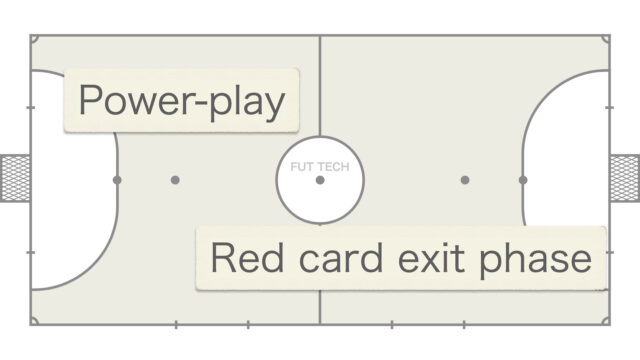In soccer, a power play involves tactics where players with strong aerial abilities, such as center-backs (CBs), are positioned as forwards (FWs). In contrast, a power play in futsal refers to the tactic where the goalkeeper participates in the attack as the fifth field player (FP), creating a numerical advantage of 5vs4 to press the attack.
While this results in a numerical advantage, it also leaves the goal wide open, increasing the risk of an immediate counter-goal (power play reversal), so it is often employed by the losing team towards the end of the match, and it is known as a double-edged sword tactic.
Therefore, the five players involved are required to have high-level ball control skills, and it is common for the goalkeeper to be substituted with a technically skilled FP.
This article provides a thorough explanation of what kind of members and mindset are necessary for executing a power play, and what specific formations exist.

The 4-second rule and the back pass rule still apply, so it is crucial for the goalkeeper (or the FP substituting the goalkeeper) to enter the opponent’s half firmly.
Once inside the opponent’s half, the goalkeeper is treated the same as an FP and is not subject to the back pass or 4-second rule.
How to Select the Five Players for a Futsal Power Play
To perform a power play in futsal, it is necessary to have five players who understand the tactics well and possess the necessary technical skills.
Since the power play requires only five players, not all team members need to be capable of performing it.
However, since the tactic of leaving the goal empty entails a high risk of conceding a goal, it is necessary to prepare five high-quality players.
So, what characteristics should be considered when selecting these five players for a power play? The following four points can be mentioned:
- Players who can stop and kick the ball accurately
- Left-footed players
- Players who can shoot from the middle distance
- Players with a high tactical understanding of power plays
The details of these four points and the reasons why players possessing these characteristics are necessary will be explained respectively.
① Players Who Can Stop and Kick the Ball Accurately
It is vital for players performing a futsal power play to be able to stop and kick the ball accurately.
While the importance of ball control skills varies depending on the formation, it is essential that all five players possess a certain level of ball control skills.
In a power play, it is common to pass the ball around while looking for chances in a numerically advantageous situation. Also, due to the attack involving five players, the team’s goal is left wide open.
If the players’ ball control skills are lacking, it becomes difficult to score reliably, and the chances of conceding goals on counter-attacks increase.
Furthermore, having a player who is extremely skilled in ball control and can provide decisive passes becomes a key offensive player.
② Left-Footed Players
In futsal, the presence of left-footed players can make a significant difference in the quality of a power play.
It is desirable to have at least one left-footed player, preferably two.
The reason is that when the player positioned on the right side is left-footed, they can create chances with a wide field of vision and accurate passes.
③ Players Who Can Shoot from Mid-Distance
Having players who can shoot from mid-distance can expand the range of attacks during a power play.
It goes without saying that players should shoot from mid-distance when the opponent’s formation is disorganized, but in power plays, there are also tactics where the player in the line (entrelínea) blocks and opts for a mid-distance shot.
Furthermore, when conducting sign plays such as block & continue (pick & roll), having a player who can shoot from mid-distance in the back increases the range of attacks.
If the opponent’s goalkeeper catches the ball during a power play, they can successfully execute a power play reversal against the empty goal.
When shooting from mid-distance during a power play, it is necessary to shoot strong and accurate shots to prevent the goalkeeper from catching the ball.
④ Players with a High Tactical Understanding of Power Plays
Players executing a power play must have a high tactical understanding of futsal power plays.
Unlike other scenarios, during a power play, it is crucial to score reliably.
However, as power plays are among the more complex tactics in futsal, if all five players are not well-versed in the team’s power play tactics, they will not be able to score and, in the worst case, may concede goals due to a power play reversal.
Additionally, the ability to adapt to irregular situations that deviate from the standard pattern is also indispensable.
Four Key Principles of Futsal Power Plays!
The following are four key points to consider when executing a power play:
- Execute a power play at the right timing
- Share a common consciousness
- Play with patience
- Have a variety of patterns
Let’s take a closer look in order.
① Execute a Power Play at the Right Timing
Starting a power play in a haphazard manner just because you are losing is not a good idea.
If a positional attack is working well, there is no need to force a power play. The ability to read the flow of the game is crucial.
Also, it’s important to calculate the time and score difference and share the vision of victory with the team, such as “if we score X goals in X seconds, we can win”.
② Share a Common Consciousness
Sharing a common consciousness within the team is important for any futsal tactic.
It’s essential for all members participating in the match to understand the tactics through regular practice and envision what the team (set) wants to achieve in their minds.
③ Play with Patience
When playing a power play in a trailing situation, it’s easy to get impatient and aim for risky plays. However, considering the risk of a power play reversal, it’s better to avoid risky plays.
Rather than taking risks, it’s a standard practice to pass the ball quickly to exploit the numerical advantage and finish reliably when the opponent’s defense shows weakness.
Comparing it to baseball, it’s important to wait patiently, avoiding balls that are borderline and swinging fully at balls that are right in the strike zone.
However, if there’s barely any time left, it’s a different story.
④ Have a Variety of Patterns
Holding as many patterns as possible for power play finishes and formations can confuse the opponent’s defense.
Having several sign plays can also lead to a more substantial attack.
While the types of formations will be explained later, changing formations during the game through rotation and other means tends to confuse the opponent’s defense more than sticking with one formation.
Introduction to Futsal Power Play Systems (Formations)
There are several types of power play systems.
Professional power plays do not stick to one system but change formations while incorporating sign plays to confuse the opponent’s defense.
This time, five representative systems are introduced.
House Formation (1-2-2)
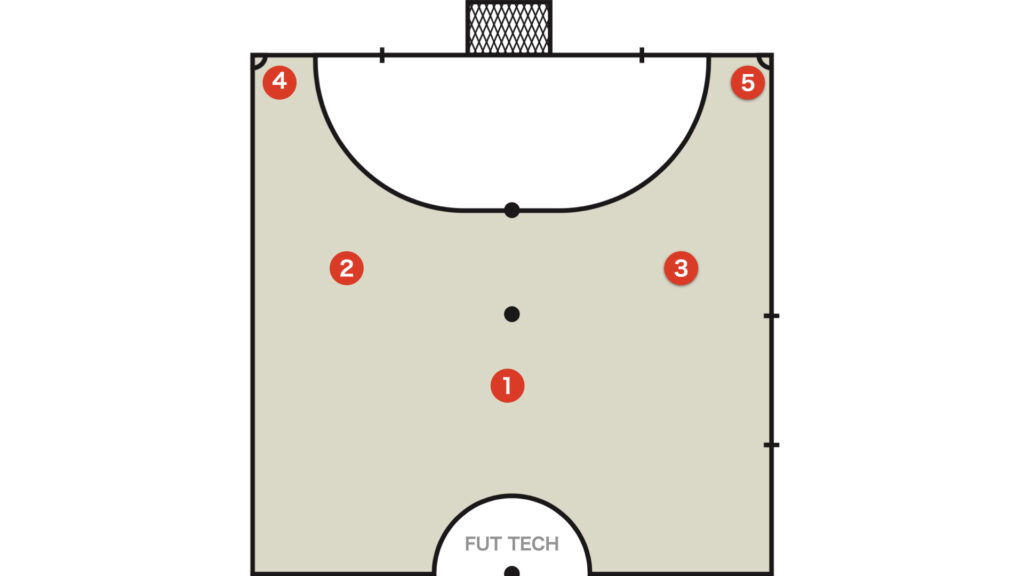
The most orthodox house formation system.
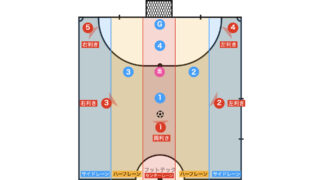
Passing the ball among the three players in the back, looking for a one-touch pass opportunity.
When the ball reaches a player in the front line, if the opponent’s defense is not coordinated, a quick pass to the far side is sent, and the opposite-side front-line player strikes a typical finish pattern.
If a team is introducing a power play for the first time, this system could be considered the safest choice.
Box Formation (2-1-2)
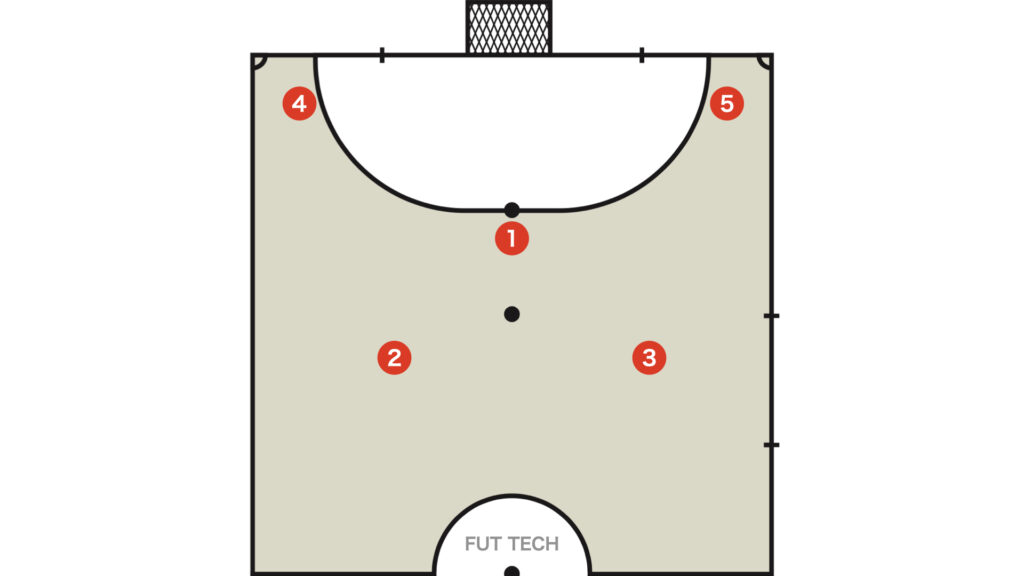
A system of 2-2 box + line between players (entrelíneas).
The player in the middle has to play in a tight space, requiring a wide field of vision, high decision-making ability, and ball control skills, making it a somewhat challenging system.
On the other hand, it offers many attacking variations and can be extremely powerful when mastered.
The play where the player in the middle blocks from behind is particularly threatening.
Also, the key is having two lines of 3 on line diagonally formed.
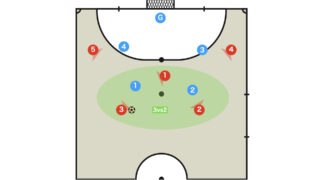
Diamond Formation (1-3-1)
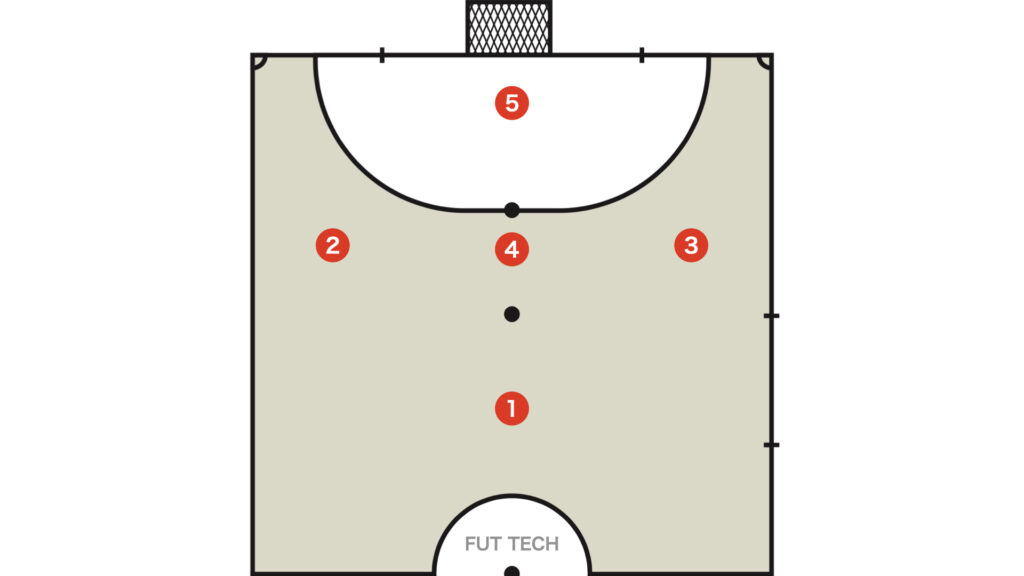
A formation that positions one player at the center (pivot) of a diamond made up of four players.
Since this formation is a 45-degree rotation of a box formation, it is effective to alternate between the two formations in sign plays.
3 on line forms two lines vertically and horizontally.
2-3 (2-2-1)
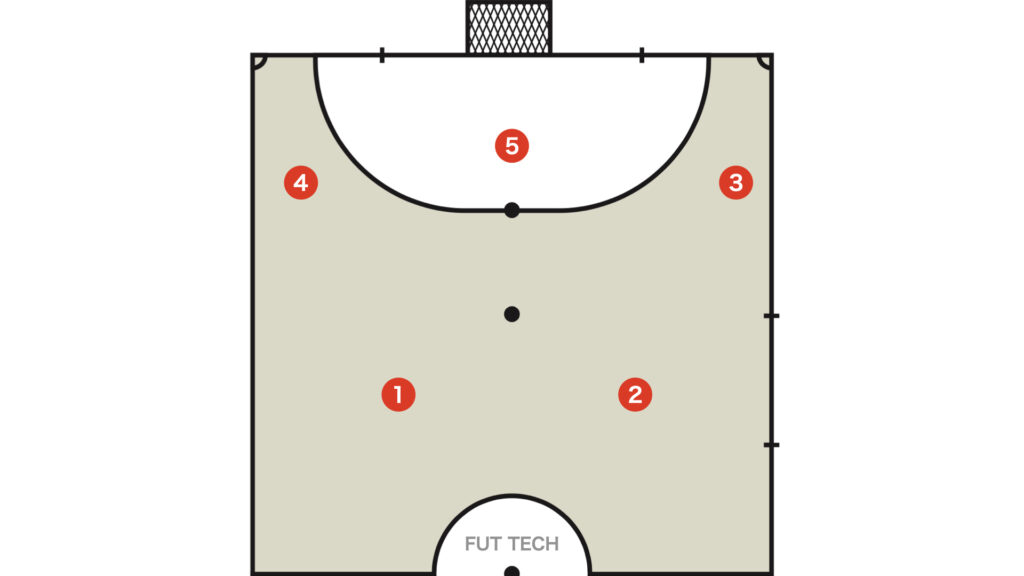
It is less commonly used, but effective when there is a pivot with a strong body capable of holding the ball.
The single player at the front (as shown in the diagram) not only creates opportunities from passes to the pivot but also disrupts the opposing goalkeeper and plays a role in far post situations.
Sometimes, dropping back to the second row to receive a pass at the pivot and create chances.
Pyramid (Tree) Formation (1-2-2)
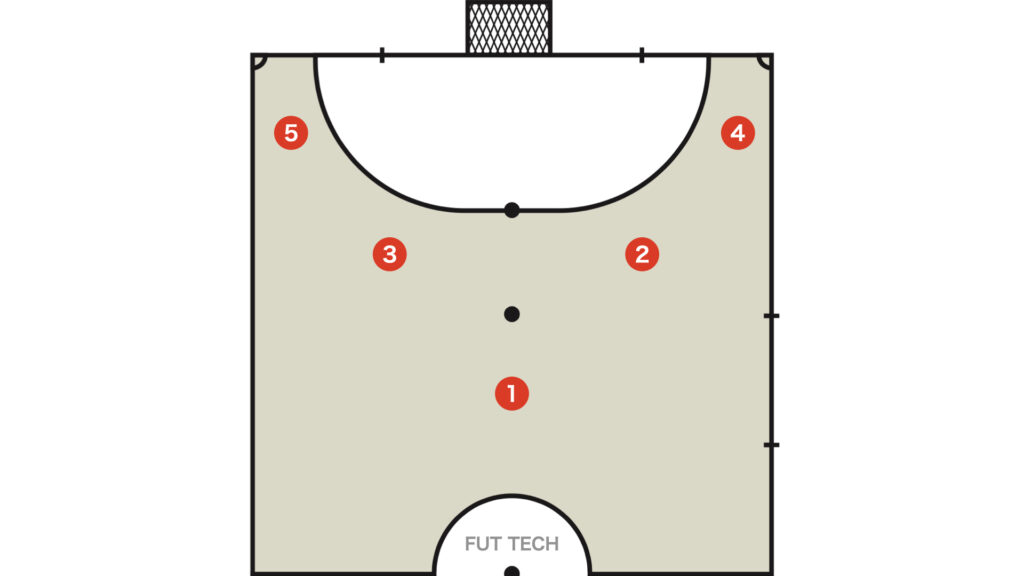
A system that spreads in a pyramid shape centered on the player at the back.
Since it forms 3 on line on both sides, it effectively utilizes this 3 on line.
By passing the ball in the back triangle and when the ball comes out to the center player of 3 on line, if the opponent bites forward, aim for a breakthrough between the lines with Alacorta.
If the middle is cut off, attacking variations increase, such as passing through to break through the sides.
Asymmetrical Left-Right Formation
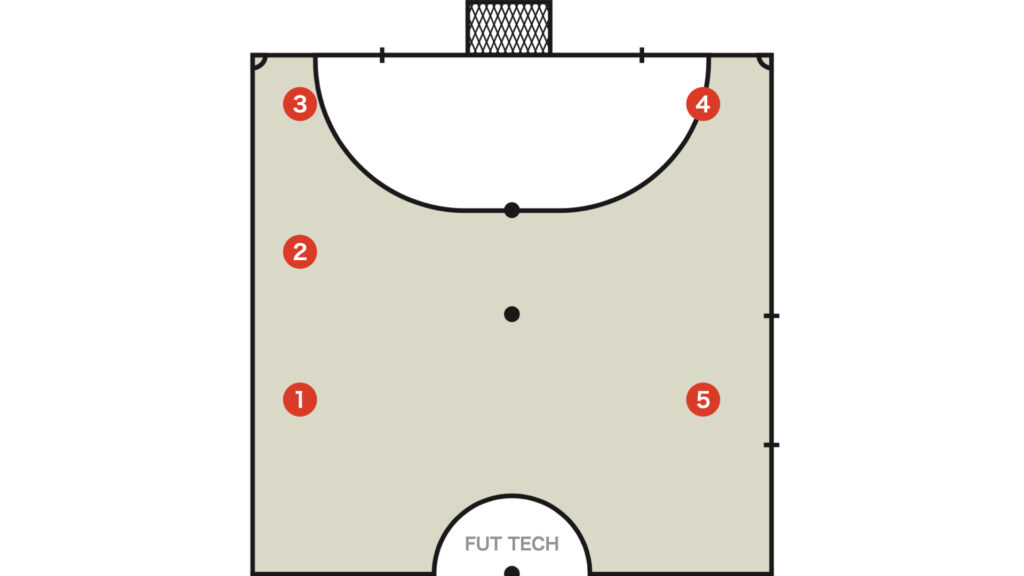
Refers to an asymmetrical formation, as opposed to the symmetrical formations explained so far.
Overload-Isolation Type
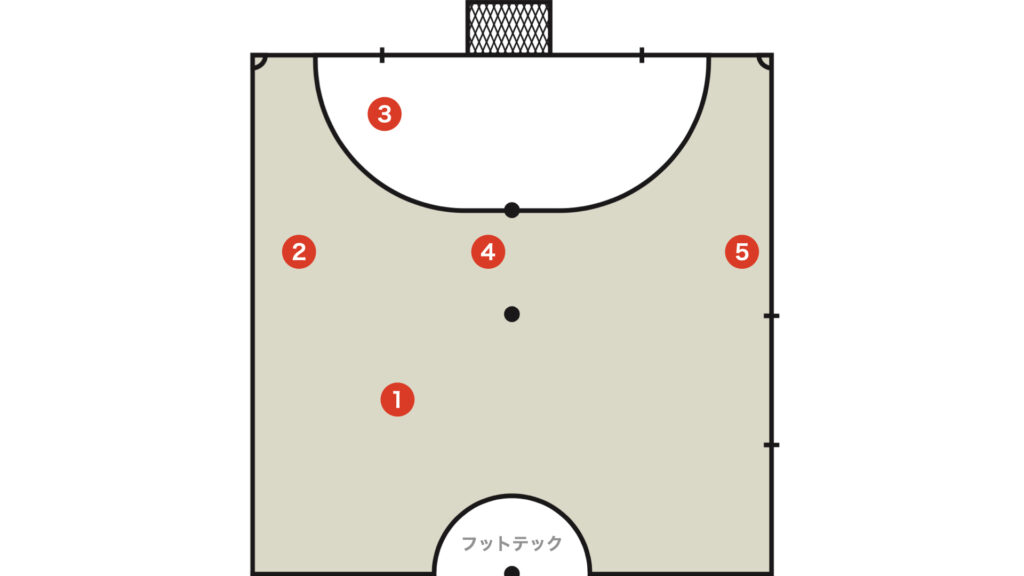
Overload is a tactic where you intentionally concentrate players on one side (a certain area) to create space on the other side (a different area) to create isolation.
It is seldom adopted in the initial formation, and is more often formed through rotation and position changes.
By forming a chaotic formation, it easily leads to defensive disarray and local numerical superiority, making it a very effective strategy commonly seen in F-League and international futsal matches.
Thank you very much for reading this article to the end.
If you found this article useful, please consider sharing it using the social media share buttons above.
We regularly share valuable insights on futsal tactics on Twitter, so if you haven’t followed us yet, we’d appreciate your support!
We are committed to raising the level of futsal in Japan by sharing high-quality information through discussions with individuals who have coaching experience in the F.League and overseas.
If you have any questions or notice any mistakes, feel free to leave a comment below.
We update our articles regularly, so if you’d like to keep reading, please bookmark our site or search for “FutTech”!
